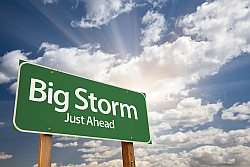It is undeniable that dramatic and strange weather patterns have been on the increase. Not only have we seen the highest temperatures ever recorded in some areas, but massive hail storms and flash floods as well.
 “The question to ask is: who caused the damage? If the damage was caused by the tenant, it is the tenant’s responsibility to fix it. If it was caused by the landlord, the landlord is liable for the damage. If the damage is nobody’s fault, the property owner is liable for repair of the damages,” says Steyn.
“The question to ask is: who caused the damage? If the damage was caused by the tenant, it is the tenant’s responsibility to fix it. If it was caused by the landlord, the landlord is liable for the damage. If the damage is nobody’s fault, the property owner is liable for repair of the damages,” says Steyn.This is all happening at the same time as other parts of the country continue to experience severe drought and devastating fires.
This is according to Managing Director of Tenant Profile Network, Michelle Dickens, who says during extreme weather cycles, physical damage to a property can be unavoidable.
But is an owner or tenant liable for this kind of damage?
“The risk and liability involved with immovable property will always be that of the owner. The owner is thus liable for all damages caused by 'vis major',” says Dickens.
She says ‘vis major’ is a legal term referring to a superior force, which is outside of human control. It includes acts of nature or acts of God such as lightning, earthquake, flood or violent storms.
Damage to the structure of the property, unless caused by the gross negligence of the tenant, is the responsibility of the owner.
“This is also the case with permanent fittings, for instance cupboards, baths, toilets or curtain rails. If the tenant causes a fire in the kitchen through gross negligence, and in so doing burns down the house, the blame - and therefore liability - for the damage falls squarely on the tenant,” says Dickens.
Cilna Steyn, Managing Director of SSLR Inc., property specialist law firm, says she can provide practical advice concerning this.
“The question to ask is: who caused the damage? If the damage was caused by the tenant, it is the tenant’s responsibility to fix it. If it was caused by the landlord, the landlord is liable for the damage. If the damage is nobody’s fault, the property owner is liable for repair of the damages,” says Steyn.
“Another way of looking at the problem is: who has the insurable interest? A tenant cannot take out insurance on a property, whereas a landlord can. Therefore, tenants cannot be held liable unless they were grossly negligent.”
How does this contrast with a property that is sold? If a property is sold but occupation has not yet taken place and the property is destroyed due to no fault of the seller, the sale is not terminated. The buyer remains liable for payment of the full purchase price.
Steyn says every set of circumstances where a dispute arises regarding damages to a property is unique, and liability can therefore only be determined on a case by case basis.
Some real case scenarios that TPN and SSLR Inc. have dealt with in recent months include:
Fire
The tenants manufactured the illegal drug methamphetamine in the kitchen and burnt down the entire kitchen as a result. Not only were the tenants acting illegally, they were grossly negligent and therefore liable for the damages.
Flood
The tenant placed a top-loader washing machine on a trolley in the garage. The washing machine toppled over and flooded the house. The tenant is negligent as it is reasonably foreseeable that the washing machine could fall off the trolley in mid-spin. The tenant is therefore liable for the damages.
Wind
The window panes were smashed when the window slammed shut as a result of sudden gale force winds. The landlord is liable for the damage as this is a case of 'vis major'.
Contractor damage
A guest of the tenant at a business park had their car window broken by the garden service who was mowing the lawn when a stone shot out from under the mower. The contractor caused the damage and was liable; the contractor’s insurance paid for the damage.
Hail storm
The entire west side of a house had windows broken in a hail storm. The landlord was liable for the damages as this is a case of 'vis major' where neither the landlord nor the tenant could control the weather.
Steyn says the simple question to ask is: whose actions caused the damage?
“Was it the tenant, the landlord or a contractor? If it was nobody’s fault, as with 'vis major', the landlord is liable as the owner of the property,” she says.








